
Display Contents
Neolithic pottery from Thanet
Early Neolithic
Middle Neolithic
Late Neolithic
Where will it end ?
Artefact scales in centimetre divisions
Feature scales in 0.5 metre divisions
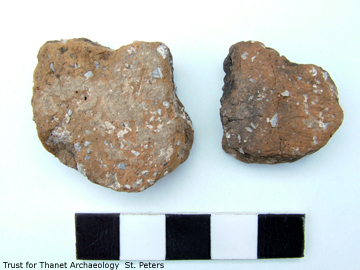
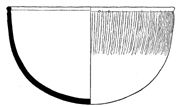
Illustration of an
Early Neolithic bowl from Nethercourt, Ramsgate
Copyright Dunning 1966
The Neolithic pottery we find is often
fragile and
survives only rarely. It is
always exciting to discover!
The
earliest pottery found on the Isle of Thanet
Encounters
with archaeological features of this date are few and far between.
Thanet’s
Early Neolithic pottery is generally represented only
by the occasional sherd.
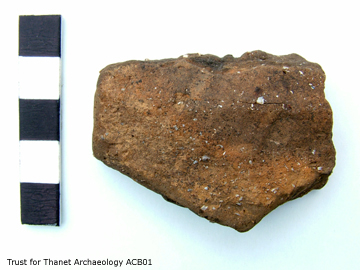
This fragment and the two simple rims
and body sherd shown below were found at
Anne Close, Birchington.
Early Neolithic pottery from Anne Close, Birchington
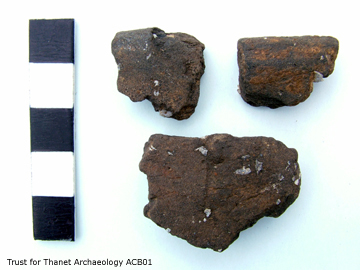
The clay used to make
the vessel had
been mixed with ground up
fragments of burnt flint. This ‘temper’ acts as an opening agent which
helps the water in the clay to escape during the firing process. This improves the chances for a more
successful firing of the pot. All of Thanet's Early Neolithic pottery
has this flint tempered fabric.
A couple of fairly complete Early
Neolithic
bowls have been found on Thanet.
The first (shown below) was found in a
grave,
discovered during the building of the Nethercourt estate. The pot had
been
broken and the sherds spread above a crouched inhumation burial (see
the display on Neolithic burials).
Copyright Dunning 1966
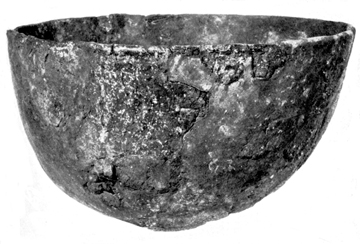
Another was found at the
inundated site
of Minnis Bay Quex Park
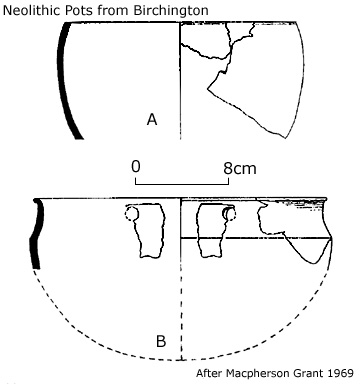
Our
most recent find of Early Neolithic pottery came in the form of a few
scraps found in a pit on an excavation site next to the QEQM Hospital

Neolithic pottery bowls from the West Kennet longbarrow
Copyright Devizes Museum
By this time the pottery was gradually becoming more intensively and ever more elaborately decorated.
An evaluation at Preston Caravan Park, Manston in 2003 produced some sizeable sherds of Middle Neolithic pottery.
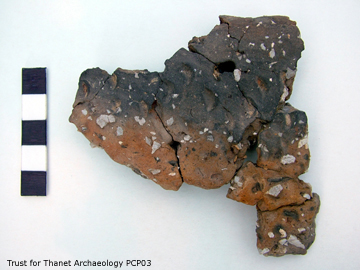
They are decorated with finger-tip
impressions which are at least 5000 years old.
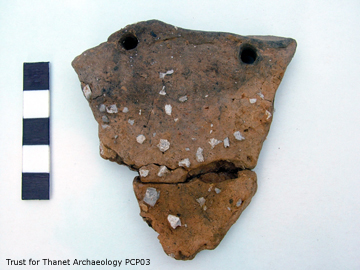
A series of holes placed just beneath
the rim may
suggest that they were used for securing a cover of some sort.
Note the decoration of finger-tip impressions
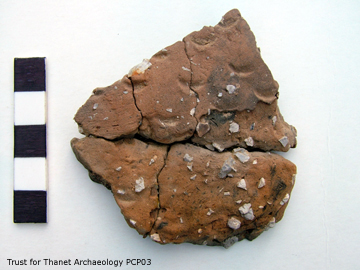
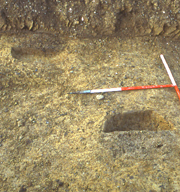
Two Middle Neolithic post-holes/pits in an
evaluation trench at
Preston Caravan Park, Manston
The pottery was recovered from two small
circular pits which could be shallow post-holes. These represent
rare and important evidence of Thanet’s
early farming communities.
Some of the pottery was recovered from the centre of these features. This means that they may have been deposited after any post had been removed, rather than having been part of the original backfill. It is also possible that these pits had another function altogether.
Illustrated below is another sherd which is also decorated with finger-tip impressions, found at Little Brooksend Farm. It is of a type known as Peterborough which broadly dates from circa 3400-2500 BC (Garwood 1999).
Some of the pottery was recovered from the centre of these features. This means that they may have been deposited after any post had been removed, rather than having been part of the original backfill. It is also possible that these pits had another function altogether.
Illustrated below is another sherd which is also decorated with finger-tip impressions, found at Little Brooksend Farm. It is of a type known as Peterborough which broadly dates from circa 3400-2500 BC (Garwood 1999).
Little Brooksend Farm
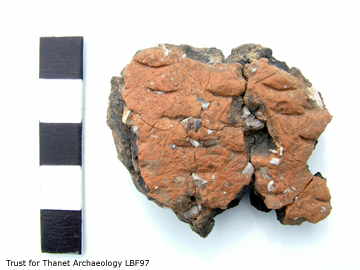
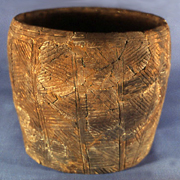
Grooved Ware pot from Durrington Walls
Copyright Salisbury and South Wiltshire Museum
This period saw the first
appearance of flat-based pottery of ‘Grooved Ware’ (illustrated left
and below)
and ‘Fengate Ware’ type.
Grooved
Ware was the first pot-form to have a flat base. It first appears on
the Scottish Isles in the Middle Neolithic period, perhaps as early as
3400 BC and its use gradually spread throughout Britain
This is linked with the spread of the Henge monument phenomena.
This is linked with the spread of the Henge monument phenomena.
In Southern Britain the instances of
Grooved Ware are thought to date
from circa 3000-2000 BC
and it is said that further research may refine this dating to around
2900-2100 BC (Garwood 1999).
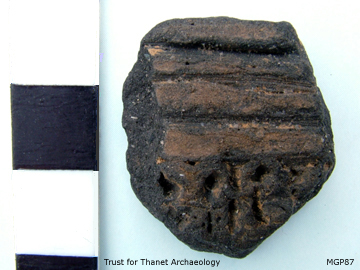
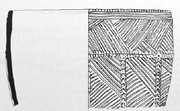
Illustration of a Grooved Ware pot from Durrington Walls
Copyright unknown at present
The term Grooved Ware reflects the
decoration on the vessels which often consists of
grooved lines forming panels which are infilled with various
abstract designs. This pottery is tempered with grog, which is the
crushed remains of other pots.
The
introduction of grog tempering represents a new innovation in pottery
production techniques. It also permitted the creation of a much
smoother
surface for applying decoration and gave a less crude looking pot.
Personally though, I rather like the
look of the heavily flint-tempered
vessels!
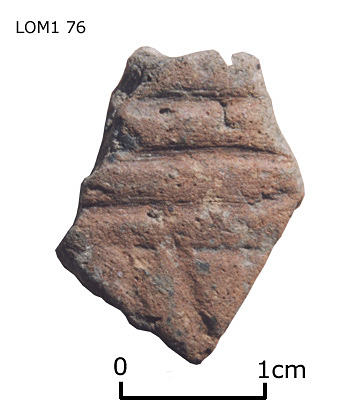
Grooved Ware is often associated with Henge
monuments and has tradionally been accorded a special status.
Only small scraps have so far come to light in Thanet; the majority from the barrows at Lord of the Manor (such as the piece shown above). Some of these roundbarrows are possibly refurbished and adapted Henge (or Hengi-form) monuments.
Only small scraps have so far come to light in Thanet; the majority from the barrows at Lord of the Manor (such as the piece shown above). Some of these roundbarrows are possibly refurbished and adapted Henge (or Hengi-form) monuments.
We
keenly await a site that produces a significant assemblage of Grooved
Ware on Thanet.
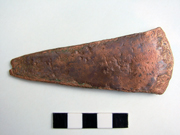
Beaker Period/Early Bronze Age Flat axe from Gore End, Birchington
The
continued use of Grooved Ware until around 2000 BC highlights a problem
created by our need to label and define different periods.
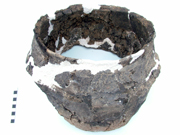
Early Bronze Age Collared Urn
from Lord of the Manor, Ramsgate
My personal preference is to use a date here for the end of the Neolithic and the beginning of the Early Bronze Age at around 2000 BC, after which no purely Neolithic pot forms continue.

Three Thanet Beakers
Beaker
vessels and their associated artefacts
occur from around 2500 – 1700 BC and thus the term ‘Beaker Period’ can
usefully define this important transitional phase between the Neolithic
and the Bronze Age; (see the Beaker
Period Display to learn more).
What is most important to remember is
that all these periods are really part of a continuum and that our
labels are just a guide in helping to characterise and explore those
cultural changes over time.
You have
now reached the transitional phase between ‘Display 4’ on Neolithic
Pottery and ‘Display 5’ on Neolithic Polished Axes.
Dunning G.C. 1966. Neolithic occupation sites in East Kent. The Antiquaries Journal - Part 1.
Garwood P. 1999. Grooved Ware in Southern Britain: Chronology and Interpretation in Grooved Ware in Britain and Ireland. Neolithic Studies Group Seminar Papers 3, Oxbow, 159; 152.
Macpherson Grant N. 1969. Two Neolithic Bowls from Birchington, Thanet. Archaeologia Cantiana LXXXIV.
Thanks to Webmeister Ges Moody for the
reproduction of Nigel Macpherson Grant's illustration of the Early
Neolithic bowls from Minnis Bay and the photograph of the Grooved Ware
sherd from LOM I.
Version 1 - posted 12.05.05
Version 2 - Posted 24.03.06
Version 3 - Posted 16.12.06
All
content © Trust for Thanet Archaeology